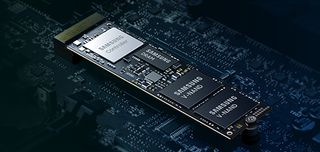The evolution of SSDs - how today's storage is faster and larger than ever

Solid State Drives, more commonly known as SSDs, are arguably the most important component in your PC, laptop or mobile device. They store all your important files, while allowing software, games and operating systems to load up quickly.
However, while SSDs feel like a particularly modern invention, they’ve actually been around for a long time – early SSDs first emerged in the 1950s, while flash-based SSDs, appeared in the 1980s.
Since then, SSD technology has come on in leaps and bounds, and there’s been one company that has been at the forefront of this storage revolution: Samsung.
Back in July 1984, the company developed 16Kb of EEPROM, an early form of flash memory. However, it was expensive to create, so Samsung turned to MROM, a form of storage favored by Japanese game consoles, such as the iconic Game Boy.
It was a financial success, but it wasn’t until the end of the 1990s when flash storage hit that mainstream sweet spot of being affordable, yet offering plenty of space as well.

NAND success
Samsung broke records, developing the first 1Gb (gigabit) NAND flash in 1999, and has since then been a leader in expanding the technology’s capacity – hitting 2Gb in 2002, 4Gb in 2003, 8Gb in 2004, 16Gb in 2005, 32Gb in 2006 and 64Gb in 2007.
This doubling of capacity every year is an astounding technological feat, and has resulted in the mobile devices we use every day benefitting from fast and high-capacity storage. Our day-to-day lives would be very different indeed without it.
SSDs hitting the mainstream
These days, it’s now very rare to find a laptop, or even a desktop PC, without an SSD for storage – but it wasn’t always like that. Before the 2000’s, PCs used traditional disc-based hard drives. While these hard drives are dependable ways of storing your data – and now come in ever larger capacities – their read and write speeds simply cannot compete with an SSD.
This is because they use a spinning disc, and the physical action of reading and writing to a spinning disc means data transfers just aren’t as fast. Also, as they have moving parts, traditional hard drives aren’t as robust as SSDs, especially if they are dropped or knocked while in use.
However, Samsung saw the potential of SSDs in the burgeoning PC market. While SSDs had been mainly used in USB memory sticks, MP3 players and other portable devices, the fast storage tech was ideal for PCs – allowing them to boot into an operating system in a fifth of the time it took traditional hard drives.
Samsung used its expertise and experience to lead the charge and bring solid state drives to mainstream computers. It changed the way we use our PCs, and the rest is history.
Get daily insight, inspiration and deals in your inbox
Get the hottest deals available in your inbox plus news, reviews, opinion, analysis and more from the TechRadar team.
